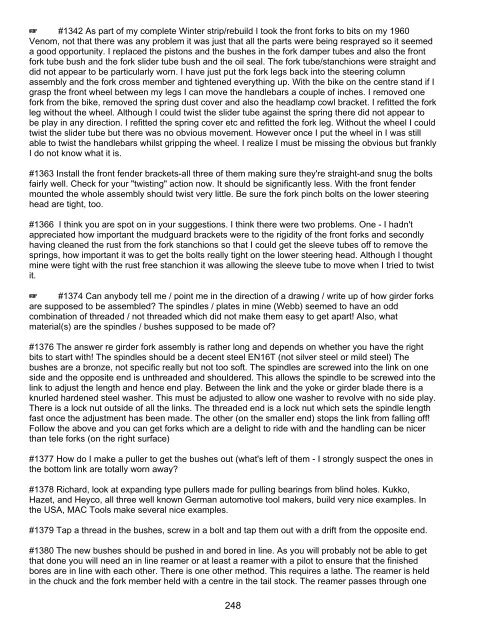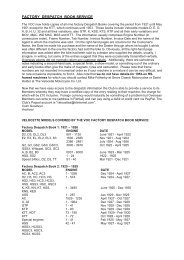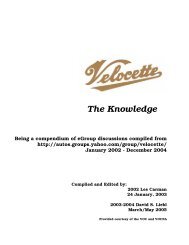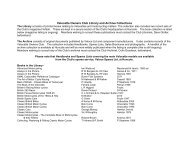The Knowledge - Velocette Owners Club
The Knowledge - Velocette Owners Club
The Knowledge - Velocette Owners Club
You also want an ePaper? Increase the reach of your titles
YUMPU automatically turns print PDFs into web optimized ePapers that Google loves.
L #1342 As part of my complete Winter strip/rebuild I took the front forks to bits on my 1960<br />
Venom, not that there was any problem it was just that all the parts were being resprayed so it seemed<br />
a good opportunity. I replaced the pistons and the bushes in the fork damper tubes and also the front<br />
fork tube bush and the fork slider tube bush and the oil seal. <strong>The</strong> fork tube/stanchions were straight and<br />
did not appear to be particularly worn. I have just put the fork legs back into the steering column<br />
assembly and the fork cross member and tightened everything up. With the bike on the centre stand if I<br />
grasp the front wheel between my legs I can move the handlebars a couple of inches. I removed one<br />
fork from the bike, removed the spring dust cover and also the headlamp cowl bracket. I refitted the fork<br />
leg without the wheel. Although I could twist the slider tube against the spring there did not appear to<br />
be play in any direction. I refitted the spring cover etc and refitted the fork leg. Without the wheel I could<br />
twist the slider tube but there was no obvious movement. However once I put the wheel in I was still<br />
able to twist the handlebars whilst gripping the wheel. I realize I must be missing the obvious but frankly<br />
I do not know what it is.<br />
#1363 Install the front fender brackets-all three of them making sure they're straight-and snug the bolts<br />
fairly well. Check for your "twisting" action now. It should be significantly less. With the front fender<br />
mounted the whole assembly should twist very little. Be sure the fork pinch bolts on the lower steering<br />
head are tight, too.<br />
#1366 I think you are spot on in your suggestions. I think there were two problems. One - I hadn't<br />
appreciated how important the mudguard brackets were to the rigidity of the front forks and secondly<br />
having cleaned the rust from the fork stanchions so that I could get the sleeve tubes off to remove the<br />
springs, how important it was to get the bolts really tight on the lower steering head. Although I thought<br />
mine were tight with the rust free stanchion it was allowing the sleeve tube to move when I tried to twist<br />
it.<br />
L #1374 Can anybody tell me / point me in the direction of a drawing / write up of how girder forks<br />
are supposed to be assembled? <strong>The</strong> spindles / plates in mine (Webb) seemed to have an odd<br />
combination of threaded / not threaded which did not make them easy to get apart! Also, what<br />
material(s) are the spindles / bushes supposed to be made of?<br />
#1376 <strong>The</strong> answer re girder fork assembly is rather long and depends on whether you have the right<br />
bits to start with! <strong>The</strong> spindles should be a decent steel EN16T (not silver steel or mild steel) <strong>The</strong><br />
bushes are a bronze, not specific really but not too soft. <strong>The</strong> spindles are screwed into the link on one<br />
side and the opposite end is unthreaded and shouldered. This allows the spindle to be screwed into the<br />
link to adjust the length and hence end play. Between the link and the yoke or girder blade there is a<br />
knurled hardened steel washer. This must be adjusted to allow one washer to revolve with no side play.<br />
<strong>The</strong>re is a lock nut outside of all the links. <strong>The</strong> threaded end is a lock nut which sets the spindle length<br />
fast once the adjustment has been made. <strong>The</strong> other (on the smaller end) stops the link from falling off!<br />
Follow the above and you can get forks which are a delight to ride with and the handling can be nicer<br />
than tele forks (on the right surface)<br />
#1377 How do I make a puller to get the bushes out (what's left of them - I strongly suspect the ones in<br />
the bottom link are totally worn away?<br />
#1378 Richard, look at expanding type pullers made for pulling bearings from blind holes. Kukko,<br />
Hazet, and Heyco, all three well known German automotive tool makers, build very nice examples. In<br />
the USA, MAC Tools make several nice examples.<br />
#1379 Tap a thread in the bushes, screw in a bolt and tap them out with a drift from the opposite end.<br />
#1380 <strong>The</strong> new bushes should be pushed in and bored in line. As you will probably not be able to get<br />
that done you will need an in line reamer or at least a reamer with a pilot to ensure that the finished<br />
bores are in line with each other. <strong>The</strong>re is one other method. This requires a lathe. <strong>The</strong> reamer is held<br />
in the chuck and the fork member held with a centre in the tail stock. <strong>The</strong> reamer passes through one<br />
248





